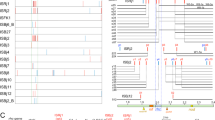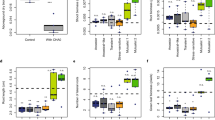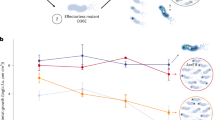Abstract
THE most striking and important feature of members of the genus Rhizobium is their ability to nodulate and fix nitrogen in the roots of legumes. There is specificity in this interaction. Legumes belonging to one cross-inoculation group are nodulated only by certain classes of Rhizobium and indeed Rhizobium species are defined in terms of the host legumes that they can nodulate—for example, R. leguminosarum nodulates peas, R. trifolii nodulates clover and R. phaseoli nodulates beans of the genus Phaseolus. The genetic bases of the nodulation process and of host specificity are poorly understood. Many Rhizobium strains harbour plasmids1–4 and genetic evidence has suggested that such plasmids might carry some of the information required for the development of the symbiosis5,6. We report here that the ability to nodulate peas can be transferred at high frequency from a strain of R. leguminosarum to a non-nodulating strain of R. leguminosarum and to three other species of Rhizobium that nodulate legumes other than peas. We infer from this that some of the genetic information required for nodulation is plasmid-linked.
This is a preview of subscription content, access via your institution
Access options
Subscribe to this journal
Receive 51 print issues and online access
$199.00 per year
only $3.90 per issue
Buy this article
- Purchase on Springer Link
- Instant access to full article PDF
Prices may be subject to local taxes which are calculated during checkout
Similar content being viewed by others
References
Nuti, M. P., Ledeboer, A. M., Lepidi, A. A. & Schilperoort, R. A. J. gen. Microbiol. 100, 241–248 (1977).
Sutton, W. D. Biochim. biophys. Acta 366, 1–10 (1974).
Tshtinge, G., Luyundula, N., Lurquin, P. F. & Ledoux, L. Biochim. biophys. Acta 414, 357–361 (1975).
Zurkowski, W. & Lorkiewicz, Z. J. Bact. 128, 481–484 (1976).
Higashi, S. J. gen. appl. Microbiol. 13, 391–403 (1967).
Dunican, L. K. & Tierney, A. B. Biochem. biophys. Res. Commun. 57, 62–72 (1974).
Beringer, J. E., Beynon, J. L., Buchanan-Wollaston, A. V. & Johnston, A. W. B. Nature 276, 633–634 (1978).
Hirsch, P. R., thesis, Univ. East Anglia (1978).
Johnston, A. W. B. & Beringer, J. E. J. gen. Microbiol. 87, 343–350 (1975).
Kleczkowska, J., Nutman, P. S. & Bond, G. J. Bact. 48, 673–675 (1944).
Vincent, J. M. A Manual for the Practical Study of Root Nodule Bacteria. IBP Handbook No. 15 (Blackwell, Oxford, 1970).
Johnston, A. W. B. & Beringer, J. E. Nature 267, 611–613 (1977).
Beringer, J. E., Hoggan, S. A. & Johnston, A. W. B. J. gen. Microbiol. 104, 201–207 (1978).
Johnston, A. W. B. & Beringer, J. E. Nature 263, 502–504 (1976).
Beringer, J. E. J. gen. Microbiol. 84, 188–198 (1974).
Prakash, R. K. et al. in Proc. 3rd Int. Symp. Nitrogen Fixation (Madison, in the press).
Author information
Authors and Affiliations
Rights and permissions
About this article
Cite this article
JOHNSTON, A., BEYNON, J., BUCHANAN-WOLLASTON, A. et al. High frequency transfer of nodulating ability between strains and species of Rhizobium. Nature 276, 634–636 (1978). https://doi.org/10.1038/276634a0
Received:
Accepted:
Issue Date:
DOI: https://doi.org/10.1038/276634a0
This article is cited by
-
Recent Advances in Lactic Acid Production by Lactic Acid Bacteria
Applied Biochemistry and Biotechnology (2021)
-
Genomic insight into the origins and evolution of symbiosis genes in Phaseolus vulgaris microsymbionts
BMC Genomics (2020)
-
Diversity and Biogeography of Rhizobia Isolated from Root Nodules of Glycine max Grown in Hebei Province, China
Microbial Ecology (2011)
-
Nitrogen-fixing bacteria associated with leguminous and non-leguminous plants
Plant and Soil (2009)
-
A histidine kinase sensor protein gene is necessary for induction of low pH tolerance in Sinorhizobium sp. strain BL3
Antonie van Leeuwenhoek (2006)
Comments
By submitting a comment you agree to abide by our Terms and Community Guidelines. If you find something abusive or that does not comply with our terms or guidelines please flag it as inappropriate.



